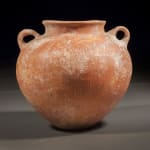A Red Burnished Slip Canaanite Jar, with Two Loop Handles. , Early Bronze I 3100 B.C. - 2900 B.C.
Further images
Provenance
The Private Collection of the Baidun FamilyMahmoud Baidun (1920-1980) founded what would become Khader M Badiun and Sons Galleries in Jerusalem, Isreal. As a young boy, Mahmoud would accompany archeologists, biblical scholars, and visiting delegations on excavation sites all over Jerusalem and other sites within the country. Earning the trust of scholars and archeologists alike, Mahmoud became an indispensable presence and guide to other visiting scholars. When Mr. Baidun entered the antiquities trade, he would be granted trade license under the British Mandate and from the Hashemite Kingdom. When Israel authorized the trade of antiquities, Mahmoud was issued one of the first antiquities licenses issued in the country. He would later forge close relationships with other merchants; slowly building a massive private collection that would go on to sell to political leaders, international museums, and private collectors globally.
Publications
Cf. Amiran, R., Ancient Pottery of the Holy Land, pp. 42-45This elegant globular vessel was made in the ancient region of Canaan, almost five thousand years ago. The construction, finish and patination are a fascinating fusion of elegant practicality and aesthetics, as the piece was clearly designed for a specific use yet at the same time has been made in a fashion designed to make the best advantage of the materials at hand. The form is essentially globular, with a small base and widely flaring shoulders that cut short to a wide, constructed neck and upraised rim. The shoulders are adorned with a pair of small, round loop handles, and the entire piece has been red slipped and burnished. It has evidently been used for a prolonged period of time to judge from the secondary use-wear to the surface, which lends it a depth of tone which is highlighted by the calcareous patination which further complexifies the polytonal nature and texture of the piece. The size indicates that it may have been a personalized serving vessel, possible for drinking.
The Canaanites are renowned for pieces such as this: their artistic heritage is characterized by well-proportioned, harmonious and subtle compositions, and an evident enjoyment of aesthetic forms, even in everyday objects. They were one of the ‘tribal’ groups of what was to become Israel, Palestine and Jordan, who had their cultural roots in the Neolithic revolution when agriculture became the standard economy in the Near East. By the Bronze Age the stability of the area and their position between great trading powers – notably Egypt and Mesopotamia – made them prosperous and culturally diverse and was a high point for artistic creation. The culture contracted with economic issues suffered by Egypt and the Mesopotamians and went through a collapse at the end of the Bronze Age due to a combination of ‘Sea People’ invasions, environmental meltdown and internal troubles in Egypt leading to loss of infrastructure throughout the Near East. Their resurgence of power in the Iron Age was matched by that of the Ammonites and Moabites, among others, and the region eventually came under control of the Neo-Assyrians by the mid 8th century BC. This piece is typical in its functionalism, geometric simplicity and harmonious use of color; it is a piece for a serious collector or a very sophisticated domestic interior.
Cf. Amiran, R., Ancient Pottery of the Holy Land, pp. 42-45





